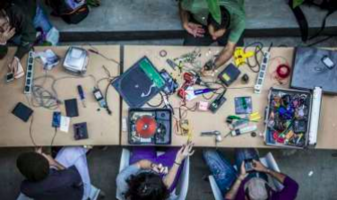Modelística: a theoretical-methodological proposal about the three-dimensional physical modeling associated with the creative process
O ato de transformar um meio físico de qualquer escala para atender a uma necessidade humana se classifica como uma representação de uma ideia, também nomeada de modelo. Tal ação é inerente a natureza humana e configura um modo de ação perante o meio em que o indivíduo está inserido, e esta é elaborada a partir da idealização consciente, dotada de inteligência e criatividade, possibilitando a ação de modelar: a Modelação. Esta pode ser utilizada para diferentes fins, desde de constituir-se como fim em si mesma, como o artesanato e as obras de Arte; até constituir parte de uma das muitas etapas criadoras de um processo projetual de um produto, o qual pode possuir naturezas distintas, tais como um utensílio, um veiculo, um edifício, uma cidade, uma ponte ou uma máquina. As modalidades da modelação podem ser de natureza uni, bi, tri ou até quadridimensionais, sendo mais comumente utilizadas em meio material as modalidades bi e tridimensionais. Sob a égide da noção filosófica bachelardiana da Imaginação criadora e da imaginação material, o ato de modelar em meio físico adquire propósitos e sentidos que ultrapassam as questões estritamente técnicas, e permitem a tomada de consciência dos preceitos do fenômeno em si, e suas possibilidades criadoras no embate entre o corpo e a matéria através das mãos, dotadas ou não de utensílios, configurando-se como uma extensão do pensamento. Enquanto recurso de representação, torna-se ferramenta, instrumento ou mesmo uma tecnologia nos processos criativos nas áreas do Design, da Arquitetura, das Engenharias e das Artes. Dentre as modalidades da modelação física, uma das mais utilizadas é a modelação tridimensional, cuja característica de simular com maior precisão e completude o objeto em processo de projeto, fato este que se deve a maior proximidade com a fabricação do intento final, torna-a uma ferramenta simultaneamente propícia para estudar, para testar e para apresentar ideias. Este trabalho tem como objetivo apresentar como contribuição original uma proposta teórico-metodológica com ênfase na dialética da fabricação de modelos tridimensionais físicos, baseada na noção da Modelação enquanto uma prática que tem um sentido, uma natureza, e uma relação intrínseca com as características físicas dos materiais, a materialidade. Partindo de uma fundamentação teórica transdisciplinar com ênfase nas contribuições da filosofia, da antropologia e da psicanálise para os campos do Design e áreas afins, buscou-se na história da modelação identificar na sua evolução a sua fenomenologia. Da lógica da modelação enquanto fenômeno, foram analisadas as experiências profissionais do autor ao longo dos últimos dezessete anos, visando iluminar e categorizar o processo do modelar, o qual foi sintetizado numa proposta intitulada de Modelística. Pretende-se que este trabalho contribua de modo geral para a ampliação da discussão acerca das temáticas circunscritas a ele, e de modo específico, contribuir para compreensão fundamental da modelação tridimensional física aplicada ao ensino e a prática profissional que envolva a Modelação.
The act of transforming a physical medium of any scale to meet a human need is classified as a representation of an idea, also called a model. Such action is inherent in human nature and forms a mode of action towards the environment in which the individual is inserted, and this is elaborated from the conscious idealization, endowed with intelligence and creativity, enabling the action of modeling: Modelation. This can be used for different purposes, from being an end in itself, such as handicrafts and works of Art; until it is part of one of the many creative stages of a design process of a product, which may have different natures, such as a utensil, a vehicle, a building, a city, a bridge or a machine. The modalities of the modeling can be of uni, bi, tri or even four-dimensional, being more commonly used in material means the bi and three-dimensional modalities. Under the aegis of the Bachelardian philosophical notion of creative Imagination and material imagination, the act of modeling in physical surroundings acquires purposes and meanings that go beyond strictly technical questions and allow the awareness of the precepts of the phenomenon itself, and its creative possibilities in the struggle between body and matter through the hands, endowed or not with utensils, configuring itself as an extension of thought. As a representation resource, it becomes a tool, instrument or even a technology in creative processes in the areas of Design, Architecture, Engineering and Arts. Among the modalities of the physical modeling, one of the most used is the three-dimensional modeling, whose characteristic to simulate with greater precision and completeness the object in the design process, fact that must provide the greater proximity to the fabrication of the final intent, makes it a tool that is both conducive to studying, testing, and presenting ideas. This thesis aims to present as original contribution a theoretical-methodological proposal with an emphasis on the dialectics of the production of three-dimensional physical models, based on the notion of Modeling as a practice that has a meaning, a nature, and an intrinsic relation with the physical characteristics of materials, the materiality. Starting from a transdisciplinary theoretical foundation with emphasis on the contributions of philosophy, anthropology and psychoanalysis to the fields of Design and related areas, the history of modeling has sought to identify its phenomenology in its evolution. From the logic of modeling as a phenomenon, the author's professional experiences were analyzed over the last seventeen years, in order to illuminate and categorize the modeling process, which was synthesized in a proposal entitled Modelística. It is intended that this work contribute in general to the broadening of the discussion about the themes related to it, and in a specific way, contribute to a fundamental understanding of the three-dimensional physical modeling applied to teaching and professional practice that involves Modeling.
